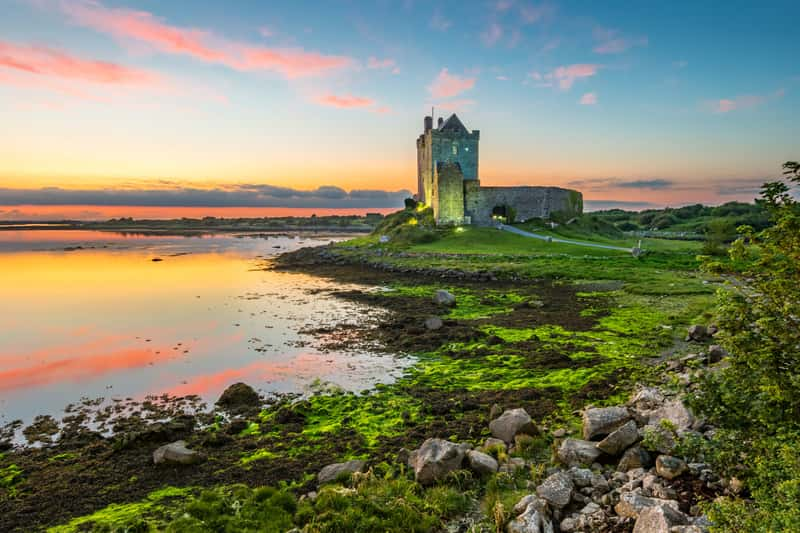She screams in the night, the harbinger of doom. Who is this famous fae of Irish Folklore? Meet the Banshee.
What is a banshee? And we’re not talking about one of Siouxsie Sioux's bandmates. We’re talking about that spooky Irish Fae known as the harbinger of doom, the mysterious Banshee.
The name Banshee
(Bean-Sidhe) is Old Irish for “Woman of the Fairy Mound” or Faerie Woman.
And in Celtic Folklore, she has a few names:
The one thing they all have in common is being female. But just like any woman, she is good at recreating herself. The banshee can take on many forms.
There’s a pattern with her multiple personalities. The young maiden lures people toward her as her voice sings a sweet melody. The curvy redhead is alluring and hypnotizing. The sad old crone is often seen with red eyes as she weeps for eternity.
The three facets of the Banshee have many believing that she is indeed a Celtic Triple Goddess. Similar to Morrigan, or the three Morrigna,
the shapeshifting phantom queen
of Irish folklore. Maybe we should be paying reverence to the Banshee?
Far, far away something made a single ghostly howl, like a banshee in the dark. ~ Lucy Christopher
The Banshee is not always seen, but she wants to be heard. Her shrieks are said to shatter glass and rattle bones. Her cries have become a warning. She is the predictor of death.
Banshees are known in Ireland for their melancholy keening. Keening is an Irish word that describes what women would do over a dead person’s body to protect them from evil spirits.
It was way back in 1380 that the first mention of a Banshee is recorded in Irish literature. Scotland and Wales also have their versions of fae-witch creatures who bring misfortune and doom. But the roots are arguably planted in Irish Celtic mythology.
And it appears that Banshees were selective of their Irish hosts.
Legend says there were five family names exclusive to the presence of the Banshee. The lucky five are O’Grady, O’Neill, O’Brien, O’Connor, and Kavanagh. Funnily, those are the most popular last names in Ireland. And each family had their own Banshee Legend. Truly the luck of the Irish.
For the O’Briens, their Banshee was said to be the ruler of other Banshees; her name was Eeevul. (Yikes!) And her loyal court followed her everywhere she went.

On a rock overlooking the sea at Dunluce Castle lived the O’Donnell’s family Banshee.
She sat perched above the Mermaid’s Cave and wailed. She wept and mourned for the misfortunes and deaths the family experienced. And for the O’Donnell family’s unchangeable fate..
The O’Neill’s castle stood at Lough Neagh, a lake in Northern Ireland. Beside the shores of the Lough Neagh was Coile Ultagh, the Great Wood of Ulster,
and it’s said that the Banshee, Maeveen,
would wail so loudly, she could be heard through the woods.
Maveen, also known as the White Lady of Sorrow, even had her own room in the castle. People have claimed to see an unexplainable impression in Maveen’s bed. As if her spirit was lying in wait. Could she have been a family who had passed?
In 1816, a fire began in Maveen’s room during a party at the castle. It burned down a large portion of the castle. Perhaps Maveen started the fire, angry at the strangers in her home... We’ll never know.
What we do know is that the Banshee lore grew during times of battle. There are tales told of soldiers abandoning their post during a battle. The sounds of a wailing Banshee coming from the woods surrounding them sent them running. Fearful that it was their fate she was keening for, they ran from their impending doom.
The now vulnerable soldiers would often be killed by their enemy as they fled. Or killed by their comrades for fleeing their military duties. The soldier's death would only add to the lore of the Banshee.
The Banshee legend has lovers and haters on The Emerald Isle. And the debate goes way back.
In 1893, The Irish Times posted the claims and local arguments about the Legend of the Banshee. Patrick Farrell of Kildare shared his experience:
“It was a beautiful moonlight night in December, business having detained me until a late hour and not feeling weary I determined to have a short stroll this night being gloriously fine. After some time I heard coming from a bush in the middle of a small paddock at the back of my house a long, low wail and after some time the most piteous sobbing I have ever heard. Being then a disbeliever in banshees, ghosts, goblins, fairies, leprechauns and company, I was glad of an opportunity to test once for all their genuineness.” Among the shrubs, he saw a deer; “milk-white” and “sobbing in the most heartrending manner.” Farrell watched for five minutes and then took a swing at the animal: “The stick passed through space, but I heard such a scream as I hope and pray shall never fall on my ears again.” Farrell fled the scene, to later discover that his cousin, in Australia, died the same night.
Was Mr. Farrell a witness to something more than Lore? Or was he simply spinning a tale to tell?
The Banshee’s cries have sent chills through the bones of many for centuries. And contrary to the belief that it’s only the select families who carry a Banshee with them, there are reports, like Mr. Farrell’s, of her ghostly death calls.
Some say they heard the cry for several nights in a row before experiencing the loss of a loved one. And some say she was heard just once, on the eve of a death.
Believed to have once been a mortal woman, who was overcome with sorrow never to be remedied, the Banshee is now a solo traveling fairy. She moves from place to place, fluttering like a hummingbird and leaving a cloud of mist behind her.
Now, it’s not fair to think of the mysterious Banshee as all gloom and doom. She should be thought of as a compassionate and sensitive fae. Her tears and cries are for those who have lost and for those whose time is near.
But her sister, Lianhan Sidhe - Sweetheart Fairy
is her sinister half. Lianhan Sidhe was a bit of a Siren. She would make men fall so madly in love with her that they would eventually lose their minds.
As far as an actual face-to-face interaction with a Banshee, there’s one that could be considered a Banshee meet-up. In 1437, a woman approached King James I of Scotland and warned him of his impending murder to be instigated by the Earl of Atholl. On February 4, 1437, King James I was assassinated by Sir Robert Graham, a servant of Atholl.
Was the woman who delivered his tragic fate a Banshee?
Sir Jonah Barrington and his wife were guests of the Commander in Chief of the British forces in Ireland’s home in 1801. They were awoken by a screeching sound coming from their window. The unnerving wailing sound soon turned into the name Rossmore,
repeated three times.
The next morning, they discovered the servant, Rossmore, had died at 2:30 am
At the end of the day, if you’re a fan of footie
and a pint of Guinness, why not add another Irish favorite to your list of loving all things green. Don’t we all want to know what’s coming next…
